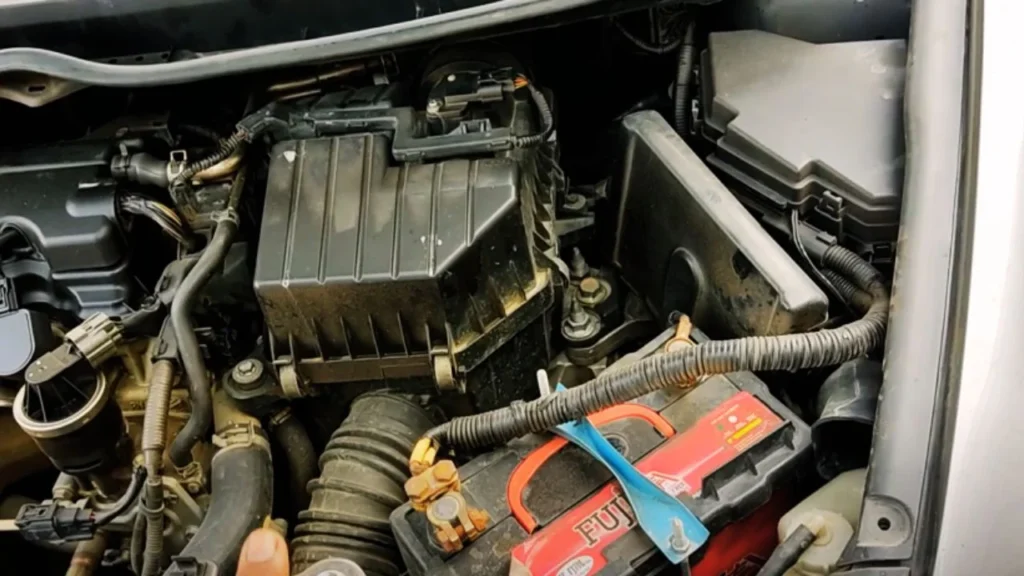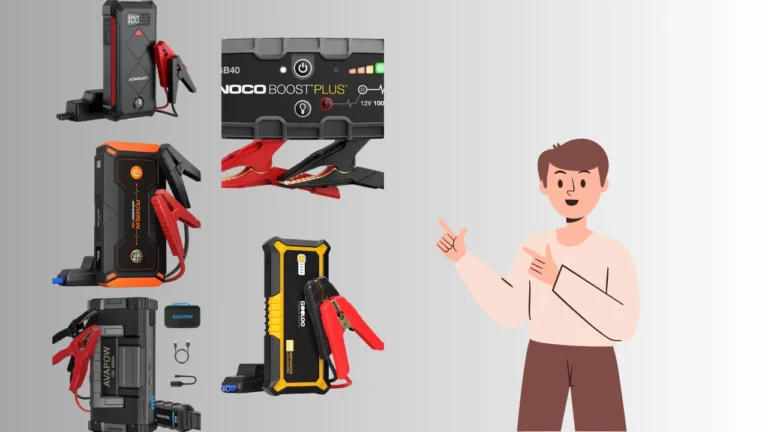When it comes to jump-starting a V8, knowing how many amps to jump start V8 can make all the difference in getting your engine roaring back to life. Larger engines like V8s require a bit more power than smaller ones, so understanding how much juice you’ll need is essential for a successful jump start. Find out How Long to Leave Cars Connected When Jump-Starting for an effective and safe boost.
Several factors come into play, such as engine type, battery condition, and even the weather. Each of these can impact the amperage needed to get that engine started, making it crucial to be prepared with the right equipment when the time comes.
Quick Look
To jump-start a V8 engine, you typically need 500-600 amps for gasoline models, while diesel engines may require 700 amps or more. Cold weather might increase these requirements. Always choose a jump starter with sufficient peak amps for reliability.
Does the type of V8 engine (gasoline vs. diesel) affect the amp requirement?
Yes, the type of V8 engine does affect the amp requirement. Diesel V8 engines generally need more amps than gasoline V8s because they have higher compression ratios, making them harder to turn over. While a gasoline V8 might start with around 500-600 amps, diesel V8s often require 700 amps or more, especially in cold weather when engine oil thickens.
Diesel engines also have larger batteries and more demanding starter motors, increasing the power needed for a successful jump-start. Always choose a jump starter with sufficient amps based on your engine type for reliable performance.
What Are Amperage Terms?
Let’s dive into what amperage means when you’re looking at jump starters. First off, you’ll often see terms like “peak amps,” “cranking amps,” and “cold cranking amps” on the device specs. Each of these numbers plays a key role in understanding how much power the jump starter can deliver.
Peak Amps Explained
Peak amps represent the maximum power a jump starter can provide for a brief burst. You might find jump starters offering peak amps ranging from 300 all the way up to 3000, especially with heavy-duty models. This high initial power helps get your V8 engine cranking, especially when the battery is completely drained.
What Are Cranking Amps?
Cranking amps, on the other hand, measure the power output a jump starter can sustain for 30 seconds at 32°F. For most V8 engines, you’d ideally want at least 400 to 600 cranking amps. If you live in a colder climate, though, cold cranking amps (CCA) become crucial.
The Importance of Cold Cranking Amps (CCA)
Cold cranking amps gauge the power needed to start an engine at 0°F, where batteries struggle. For V8s, a CCA of 500 to 700 is often recommended to ensure reliable starts in chilly weather. More amps are typically required in diesel V8s due to higher compression ratios.
How These Terms Help You Choose a Jump Starter
Understanding these terms helps you pick the right jump starter, one that matches your vehicle’s needs. It’s not just about going for the highest number but finding the right balance for your engine type and driving conditions.
How Many Amps to Jump Start V8?
When it comes to jump-starting a V8, you typically need a bit more power. Most V8 engines can get going with about 400 to 600 amps. That range works well for standard gasoline engines in regular cars and smaller trucks.

However, if you’re dealing with a diesel V8, the story changes a little. Diesel engines usually need around 500 to 700 amps because of their higher compression ratios. Some larger diesel trucks might even require up to 1,000 amps to ensure a successful start.
In colder weather, these numbers can go up quickly. When the temperature drops below freezing, a jump starter with at least 800 amps is often recommended. That extra power compensates for the thickened engine oil and decreased battery efficiency. Discover the Best Jump Starter for EV to keep your electric vehicle charged and ready.
Factors Affecting the Required Amps
When jump-starting a V8, it’s not just about grabbing any jump starter. You’ve got to consider a few key factors that can really influence how many amps you need. Let’s break it down.
Engine Size and Type
Not all V8s are created equal. A gasoline V8 usually needs 400-600 amps, while diesel V8s can require up to 700 amps. Why? Diesel engines have higher compression ratios, meaning more power is needed to get them started.

Battery Condition
Did you get an old battery? You’ll probably need more juice. Batteries lose efficiency over time, so a weak one might demand 25-30% more amps to jump-start than a new battery would. It’s always good to check your battery’s health.

Weather Conditions
Cold mornings can be a real hassle. At temperatures below 0°F, you might need 50% more amps to get that V8 going. The oil thickens, and batteries tend to lose their punch, so having a high amp rating can be a lifesaver in winter.
Vehicle Age and Maintenance
Older vehicles or those with poor maintenance might not start as easily. If your V8 is over 10 years old, you could need around 700-800 amps. Regular battery checks and keeping connections clean can reduce the strain.
Choosing the Right Jump Starter for a V8
Getting the right jump starter can make all the difference when dealing with a dead V8 engine. It’s not just about the amps but choosing one suited to your engine type and weather conditions. Let’s break down what you should look for and why.

Know the Power You Need
When picking a jump starter for a V8, it’s all about finding the right power. For most V8 engines, I’d recommend at least 600 amps to ensure a smooth start. If it’s a diesel V8, you’ll want around 700 amps due to the extra compression.
Consider Cold Weather Challenges
Cold weather makes things tricky. In freezing conditions, amps can go up to 900 or even 1000 to account for thicker oil and sluggish batteries. Trust me, it’s worth having that extra power, especially when temperatures dip below 0°F.
More Isn’t Always Better
You might wonder, “Isn’t more always better?” Well, not exactly. Aim for a device with peak amps of at least 1000 for versatility, but remember, the vehicle’s electrical system only draws what it needs.
Safety Tips for Jump-Starting
Jump-starting a vehicle can be dangerous if not done correctly. To ensure safety, follow these basic guidelines and precautions to avoid injuries or damage to your vehicle.
Wear Protective Gear: Always use gloves and eye protection to avoid exposure to battery acid or sparks.
Check the Battery: Inspect the battery for any visible damage, cracks, or leaks. If there’s significant damage, avoid jump-starting and seek professional help.
Ensure Proper Connection: Attach the jumper cables correctly—positive (+) to positive and negative (–) to a grounded metal part of the engine, not directly to the battery. This reduces the risk of sparks near the battery.
Avoid Flammable Areas: Make sure the jump-start is done away from flammable substances, as batteries can release flammable gases.
Turn Off Electronics: Before starting the jump, switch off all electronics in the vehicle, such as lights and radios, to prevent power surges.
Maintain a Safe Distance: Keep hands, clothing, and tools away from the engine to avoid accidental contact with moving parts.
Follow Manufacturer Instructions: Refer to your vehicle and jump starter manuals for specific guidance.
Common Mistakes to Avoid
Trust me, I’ve seen it happen. People often think any jump starter will do, but not checking the amps can be a costly mistake. For a V8, using less than 400 amps might leave you stranded. Aim for a jump starter rated at 600 to 1000 amps, especially for trucks or in cold weather.
Another biggie? Forgetting to inspect those jumper cables. Make sure they’re thick enough to handle at least 500 amps. Thin cables won’t cut it; they could heat up and fail, leaving you worse off than before. Cable thickness matters more than you’d think.
Battery condition plays a huge role too. An older or heavily discharged battery could need up to 700 amps to kick-start your engine. If you’re struggling to jump-start, consider replacing the battery soon—it might just save you a future headache.
Can using too many amps damage my vehicle’s electrical system?
No, using a jump starter with more amps than needed won’t damage your vehicle’s electrical system. The starter motor will only draw the necessary current to start the engine, regardless of the jump starter’s power. However, using the correct voltage is crucial, as an incorrect voltage could harm the electrical components. Learn the steps in How to Jump-Start a Car with Another Car to safely get your vehicle running again.
Wrap Up
So, when it comes to “How Many Amps to Jump Start V8?”, aiming for at least 500-600 amps is usually needed for most V8s. For diesel engines, expect to require around 700 amps, especially in colder weather.
Having a jump starter with at least 1,000 peak amps offers added flexibility, ensuring you’re prepared for any situation. Trust me, the right jump starter can save you from being stranded on the road. Stay safe and ready!
Ali is a tech enthusiast and automotive aficionado, passionate about sharing insights on the latest innovations and industry trends.





